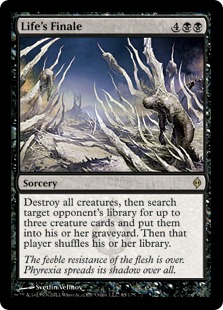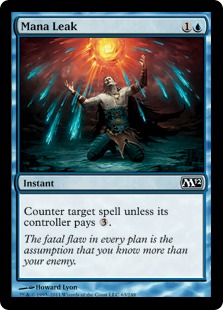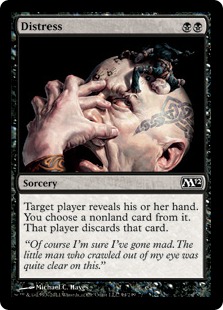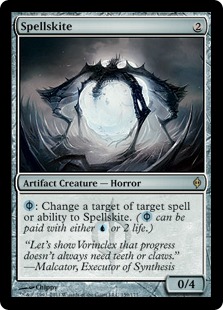Ever since M13 came out, I’ve been entranced by Battle of Wits. I share the sentiment that many of the pros have written across strategy sites and on Twitter: Battle of Wits is exciting. I’ve scoured the articles posted thus far, but I feel that there is room for improvement in many of the decklists when building for paper tournaments— first draft concepts by Ali Aintrazi and Adam Prosak and Patrick Chapin self-described “probably too ambitious” Esper list, as well as more refined ideas by Sam Black and Michael J. Flores. Many of the first draft concept lists are too ambitious with their curve and mana requirements, while the recent refined lists run into some of the unique challenges posed by playing with a physical deck with 240-250 cards.
After working on my own lists, testing, and some FNM-level tournament success, I’m here to give you some advice on how to build Battle of Wits for paper tournaments. I’ll start with some core concepts, go over key pitfalls and tips for card selection, then show you my tuned U/B Combo Control Battle of Wits list and walk you through how I’ve applied these concepts when building my list.
Key Takeaway 1: The Same Rules Apply
The most important lesson and the key theme that you’ll see presented throughout this article is that the same deckbuilding constraints apply to your deck whether it’s 240 cards or 60 cards. You can’t simply break the rules of 60-card deckbuilding and expect it to work because your deck happens to be four times the size. Many of the first draft decklists presented before the release of M13 fell into the traps described in the ever-relevant article “The Danger of Cool Things.”
Key Takeaway 2: Battle of Wits Is Consistent If You Build It That Way
Perhaps the biggest surprise to those who’ve never played 240-card decks is how consistent they can be. After I got some experience building with Battle of Wits, my seven-card hands looked like any other tuned deck’s would, with a reasonable curve and balanced color requirements.
Much like in a 60-card deck, if you have good ratios your hands are going to be balanced most of the time. A well-built 240-deck will have a lot of similarly strong opening hands that just happen to be composed of different individual spells. A U/B Control deck may have six removal spells. If you build your Battle of Wits deck with 24 removal spells, your hands are going to achieve a similar mix of removal.
When choosing your spells, it’s important to avoid getting too cute. If you include too many situational answers, you increase the likelihood of drawing awkward hands. A focus on consistency in difficult scenarios (as opposed to maximizing power in the best-case scenario) needs to be taken when building a deck with as many different possible opening hands as a 240-card deck inherently has.
If you look at a deck like Birthing Pod, the most successful Birthing Pod decks are built to do a pretty good job of executing their game plan without drawing Birthing Pod. The less successful ones frequently open on awkward hands with narrow cards that are only great as part of an occasional Pod chain. The latter type of hand is going to get run over by many aggressive decks before it even has a chance to get traction.
Key Takeaway 3: The Limitations of Shuffling in Paper Magic Place Unique Constraints on Deck Construction
A few years ago, Mike Flores wrote an article for this very website where he presented the following analogy.
“Imagine a jar that can hold 120 marbles. Imagine you pour 40 white marbles into that jar and then 20 red marbles on top of those. Then imagine shaking that jar vigorously for twenty minutes… The longer you shook the bottle, the less likely that the white and red marble groups remain segregated.”
He goes on to say—and this is important—
“The most random configuration for this stack of 60 is going to be a distribution of mana and spells broken down by percentage lands versus percentage spells with specific types of lands and spells distributed over the deck, if not distributed evenly.”
That analogy really struck a chord with me, and ever since then I’ve gone above and beyond my already vigorous shuffling tendencies. The thing with playing a paper Battle of Wits deck is that you’re not shuffling one deck, you’re shuffling four. Assuming you’re shuffling for a similar length of time as a 60-card deck, the fact that you’re shuffling four times as many cards puts serious limitations on how thoroughly any one section of your deck is going to be randomized.
One way to look at it is that it takes a lot longer for a bigger jar of marbles with four times as many white and red marbles to even out. (It’s important to note that the rules call for sufficient randomization; this is different than completely randomized.)
Another way to look at is unless you’re breaking some Guinness Book records for world’s largest hands, you’re only shuffling a section at a time. It’s like dividing that jar into a few layers and shaking one layer at a time. The layers have a lot less opportunity to intermix, and it’s a lot harder to get the whole distribution to be even.
Now that we’ve got some core concepts out of the way, I’ll move on to specific pitfalls to avoid when building your Battle of Wits deck.
Pitfall 1: Mind Your Curve
My local shop is brutal. There are a lot of creative brews that you don’t see on the net but still kill you on turn 4. It’s easy to think that you can just start jamming five-, six-, and seven-mana threats in your Battle of Wits deck while you fantasize about using Karn to restart the game with both Battle of Wits and a Nicol Bolas, Planeswalker in play. You’re not going to live that long—you need to focus substantially on early action.
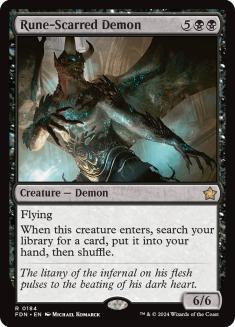
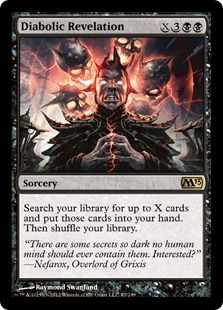
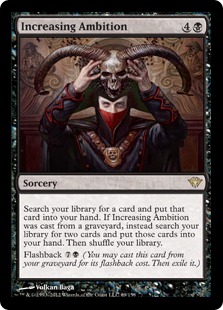
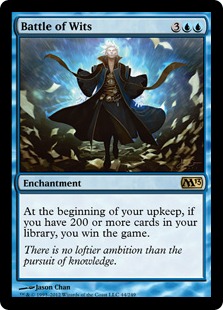
“Don’t forget to count these when examining your curve.”
Perhaps the biggest thing people seem to be forgetting is that your Tutors + Battle of Wits already eat up nearly your top end slots. In some ways the Tutors are more like a six or seven casting cost spell because they often don’t do anything the turn you play them. You have to count the Tutors as your big drops, meaning you have even less room than you thought. Running one or two seven casting cost spells is about the limit of most decks. If you’re running four Rune-Scarred Demon and four Diabolic Revelation in your 240-card deck, then frankly you’re out of slots at the top of your curve.
Pitfall 2: Include Plenty of Early, Proactive Action
The same thing goes with cantrips—it’s easy to think you can play a ton of draw spells. I used to play a lot of draw go back in the day. Splitting your deck between card draw and counterspells used to be good way to build a deck, but it isn’t anymore.
Recently, people have debated whether cards like Think Twice even deserve a slot in control decks because the card simply does nothing early, and it’s not uncommon to see lists shaving down to two or three. The same applies to Battle of Wits decks—you honestly can’t expect to draw cards for the first four turns of the game and still be alive to cast your Battle of Wits on turn 5. You need spells that impact the board and interact with your opponent, especially in today’s aggressive Standard environment.
Pitfall 3: Don’t Get Greedy with Color Requirements
This is another area where I see a lot of builders making a mistake right off the bat. The reason is that, as far as color-producing lands go, your deck is going to be 75%—80% basics. This is further compounded by the difficulty of physically shuffling a 240-card deck to get an even distribution of basics. I see ambitious lists where the only way to curve out is to go turn 1: Island, turn 2: Swamp, turn 3: Swamp, turn 4: Mountain, turn 5: Island— you’re not going to hit that exact order running 75% basics.
BUG’s sixteen dual lands may sound like a lot, but really your percentage of dual lands is the same as a 60-card Boros deck which only has 4 Clifftop Retreat. Esper and Grixis one up BUG with the equivalent of a whopping five duals. You can’t plan on hitting your duals every game to curve out.
Taking it a step further, think about a deck like Esper / Solar Flare when Innistrad came out. Each game you were hoping to curve Think Twice (blue) into Liliana of the Veil (double black) into Day of Judgment (double white), and it simply wasn’t realistic. The deck had put up some finishes, but it really came into prominence with the addition of Evolving Wilds and a shift in deck construction to having black be a light splash. If you look at the evolution of G/R Aggro, there was time during Dark Ascension when people were cutting Hellrider because they were having difficulty consistently hitting Strangleroot Geist on turn 2 followed by Hellrider on turn 3 or 4.
In my opinion, playing a two-color deck is currently the only way to go when building a paper Battle of Wits deck. Admittedly, this is a tradeoff—I’m trading some raw power and card quality for a more consistent deck. Two colors forces me into an archetype that’s not as well positioned now (U/B Control) rather than going for a more powerful and more recently successful core like Naya Pod or Wolf Run Ramp.
If you want to splash a third color, you can go one of two ways. The first is to make green a core color and include a critical mass of color fixers such as Birds of Paradise, Rampant Growth, Farseek, Borderland Ranger, and the like. I believe these lists are less competitive in paper Magic because they are less consistent. It’s difficult to shuffle your deck enough to get a consistent distribution of three to four colors, especially when you realize that you need a consistent distribution of not only lands but also spells.
It’s also worth noting that running a ramp deck, which does a whole lot more Tutoring and shuffling than your average archetype, is going to put additional pressure on the pilot. You’ll need to do all of this searching and shuffling in a timely manner, as well as manage the clock because your deck simply takes more time to operate.
The second approach to splashing a color is making it a light splash. In my opinion, this is the way to approach Esper and Grixis builds. By light splash I mean no double color requirements in the casting cost, and I wouldn’t run many cards that you need to see and play early to get their maximum effect. With three colors, you’re going to have difficulty hitting all your colors and those specific cards on the turns you need them. My first Battle of Wits build was Esper, and I frequently had Day of Judgment stranded in my hand staring at board full of Islands and Swamps or I was spending all of my resources trying to find a black source so that I could cast the Diabolic Tutor stuck in my hand.
Now that you know what types of traps to avoid, I’ll move into some tips for maximizing your card slots.
Tip 1: Specialization vs. Redundancy
One thing to keep in mind is that you’re generally going to be including certain classes of cards: cantrips, spot removal, sweepers. There’s enough redundancy in Standard that you can include sufficient numbers of each, but each is going to have different specialties. For example, Ratchet Bomb is good versus tokens but may not be the strongest versus a Birthing Pod deck, which tends to have a diversity of casting costs. Sorin’s Thirst is a strong removal spell against a deck like Zombies but doesn’t do much against Wolfir Silverheart or Restoration Angel.
When choosing your cards, you want to first max out on the types of effects you want the most against the decks you expect to see frequently and have the most difficulty with. If you have six slots available and three cards you’re looking at, the answer is often to go with four of the card that’s strongest in your metagame and one of each of the others. That will give you the best chance of being consistently good against the decks you expect to face.
Tip 2: Maximize Overlap & Flexibility
When building your list, also try to choose cards that are flexible and can take different roles in different situations. Since you’re only going to be seeing a small percentage of your deck each game, having versatile cards will give you more play than having an awkward mix of bullets. For example, Ratchet Bomb is an answer to both Oblivion Ring and creature swarms, and Nihil Spellbomb is a cantrip that is also an answer to undying and Snapcaster Mage. Even something as simple as Vessel of the Endless Rest is a flexible card; it’s a ramp spell and color fixer that puts Ponder or Mana Leak on the bottom against Delver decks.
Analyzing My List
Here is my current, tuned list of Battle of Wits. It plays out like a traditional combo-control deck, aiming to attack the aggressive metagame with a critical mass of removal until I can find and resolve a Battle of Wits. I’ve tilted the list toward early spot removal, included a life gain subtheme, and attempted to minimize cards that require shuffling to address the unique limitations of playing with physical cards. It’s surprising how many decks are cold to the card Battle of Wits, so I’ve built the deck around surviving long enough to hit that point of inevitability.
Rather than do a card by card, I’m going to go over list and talk about the ways I’ve avoided pitfalls and maximized my card slots to make the deck consistent and powerful.
Creatures (28)
- 4 Solemn Simulacrum
- 4 Vampire Nighthawk
- 1 Grave Titan
- 1 Consecrated Sphinx
- 2 Spellskite
- 4 Phantasmal Image
- 4 Rune-Scarred Demon
- 4 Snapcaster Mage
- 4 Augur of Bolas
Planeswalkers (4)
Lands (98)
Spells (108)
- 4 Diabolic Tutor
- 4 Mana Leak
- 4 Distress
- 1 Mutilate
- 2 Barter in Blood
- 4 Battle of Wits
- 4 Think Twice
- 4 Ponder
- 4 Doom Blade
- 4 Ratchet Bomb
- 4 Nihil Spellbomb
- 4 Sphere of the Suns
- 4 Black Sun's Zenith
- 4 Go for the Throat
- 4 Pristine Talisman
- 4 Batterskull
- 4 Gitaxian Probe
- 4 Dismember
- 4 Life's Finale
- 2 Sorin's Thirst
- 4 Manalith
- 4 Forbidden Alchemy
- 4 Sever the Bloodline
- 4 Dead Weight
- 4 Tribute to Hunger
- 4 Increasing Ambition
- 4 Amass the Components
- 4 Vessel of Endless Rest
- 3 Diabolic Revelation
Sideboard

Avoiding Pitfall 1: Minding My Curve
You’ll see my list only has three high casting cost win conditions outside of the Battle of Wits + Tutor package: one Grave Titan, one Consecrated Sphinx, and one Karn Liberate. Many of these slots are taken up by Tutors and win conditions (Battle of Wits, Increasing Ambition, Rune-Scarred Demon, and Diabolic Revelation) as well as Life’s Finale. Having multiple 6-7 drops in your opening hand can be a challenge for this type of deck—you need to survive long enough to cast them.
For my 6-7 drops I tried to choose cards that would have an immediate impact on the board and that have a proven track record of helping you stabilize and pull ahead in the game. I’ve also chosen to max out on things like the five casting cost Batterskull over more six-drops such as Wurmcoil Engine.
Avoiding Pitfall 2: Including Plenty of Action
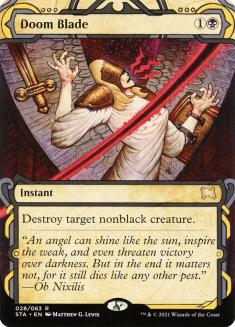
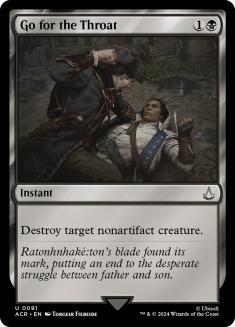
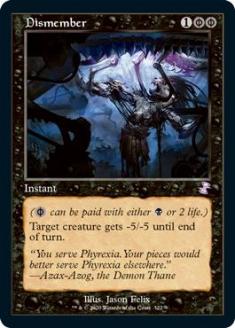
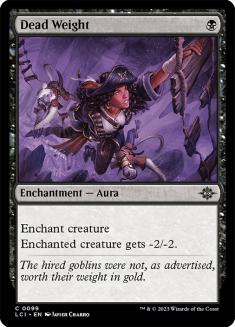
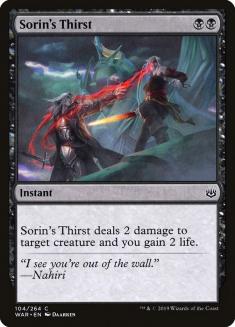
The deck is built to include a heavy spot removal suite. This is complimented by cards like Augur of Bolas and Vampire Nighthawk, which help stabilize early. I want to be matching my opponent’s early drops with efficient answers. I’ve included a greater focus on inexpensive and versatile cantrips over more expensive cards like Divination.
I was surprised when Mike Flores wrote in his Squash! Splat! BUG Battle article that he was seldom tapping his mana in his early U/B builds. With this build, I find myself more often choked on mana in the early turns, trying to establish a board presence with early interactive creatures and removal spells while also ramping.
Avoiding Pitfall 3: Not Greedy with Color Requirements
I’ve already gone on at length on why I believe a blue/black shell is best, so here I’ll go over my specific land choices. The deck is geared towards getting double black early. Both the mana base and spell selection is slanted this way. The ramp spells not only help accelerate me, but also go a long way as far as color fixing goes. Since it’s a deck that’s nearly 80% basics, I’ve included a full set of Shimmering Grotto, something typically not found in a two-color deck, and even the set of Ghost Quarter can color fix in a pinch.
I chose to avoid utility lands like Nephalia Drownyard, Phyrexia’s Core, and Buried Ruin in favor of a purely redundant mana base. Again, it’s easy to think that just because you have the space you should be including all sorts of niche effects. My line of thought is that there are only a few rare corner cases where I would want any of those lands, and I don’t expect to ever Tutor for them. On the flip side, since my deck is aimed at having getting BB early then UU in the mid game I do actively want consistency every game.
Implementing Tip 1: Specialization versus Redundancy
Perhaps the best example of this is the full set of Sever the Bloodline. I found undying creatures were a significant problem, so I’ve moved towards a full set of Sever the Bloodline over cards like Barter in Blood.
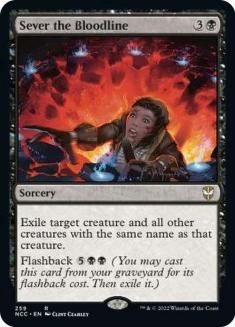
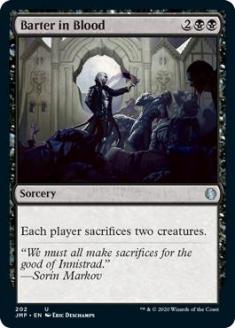
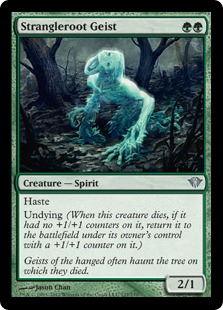
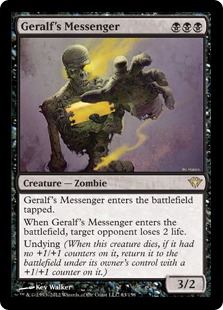
I really liked Victim of Night as an efficient spot removal spell, but after a strong showing by Zombies at the SCG Standard Open in Las Vegas I’ve shifted those slots to more Dismember and Sorin’s Thirst. Dismember answers most of the same threats that Victim of Night does, while Sorin’s Thirst is a good answer against Zombies.
Implementing Tip 2: Maximize Overlap & Flexibility
In this list I’ve tried to emphasize versatility in all of my card choices. Mana Leak and Distress can protect Battle of Wits and can be used early and proactively to address threats that U/B struggles to address like artifacts and enchantments or creatures like Geralf’s Messenger that are tough to deal with.
Spellskite can protect Battle of Wits from removal spells and block early aggressive creatures, and it’s a card I’d like to move toward playing the full set of main. As I mentioned earlier, Nihil Spellbomb addresses a number of threats, so it got the nod over the instant speed Thought Scour. Ratchet Bomb can be a slower sweeper but is a great hedge against Obilivion Ring exiling Battle of Wits.
A Note on the Sideboard
The sideboard builds on Adam Prosak advice in his article. Prosak said, “Searching through your entire deck for the perfect card to take out is simply too time consuming and not worth the time… I might play a sideboard with very narrow cards and just pick up a stack and take out the first X nonessential cards I see.”
Based on this advice, I’ve built my Battle of Wits sideboard around swapping types of effects rather than one for one swaps. This simple focus allows me to pivot the deck and reduces time sideboarding.
Against threat-light control decks, I swap out a chunk of removal spells for a heavy suite of counterspells and the potent threat Jace, Memory Adept.
Against the most aggressive decks like Zombies and G/R Aggro, I bring in Wall of Tanglecord, a perpetual blocker that usually doesn’t die to Bonfire of the Damned and can be difficult for aggressive decks like Zombies to burn out even after it blocks. Typically, I’ll swap out early answers that are less effective against those specific decks. This includes cards like Phantasmal Image (too fragile), Doom Blade (always dead versus Zombies), and Tribute to Hunger (an expensive way to kill a Llanowar Elves versus G/R Aggro).
And In Conclusion…
I do firmly believe that, if built properly, Battle of Wits is a competitive tier 2 deck that is fully capable of taking down FNMs and other local tournaments. There are quite a few decks that have no way to remove enchantments or otherwise interact with Battle of Wits, and the critical mass of removal makes it reasonable against all but the fastest aggro decks. Additionally, many control decks have moved away from counterspells, putting you in a good position to race.
As a competitive Johnny and combo-control aficionado, I find Battle of Wits inherently fun. I also think it’s the type of deck that has something for everyone. If you’re a competitive player, you’ll notice your opponents will underestimate the consistency of your deck and keep loose hands. If you like solving puzzles and complex board states, you’ll find the diversity of hands keeps you challenged. If you’re a social player, I guarantee this deck will get you a lot of birding and people cheering on. And if you’ve ever felt cool shuffling up 61 or 99 cards, then just wait until you shuffle up 238…
Take your game to the next level and try Battle of Wits at your next FNM or local tournament. You will have fun.

